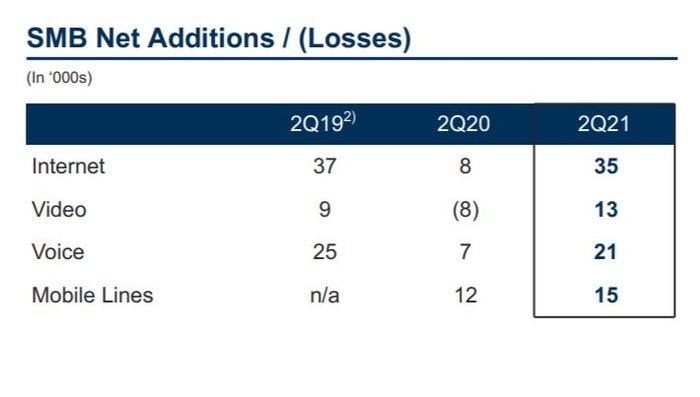Cable Update: Altice, Charter, Comcast, Shaw Increased Business Revenue in Q2Cable Update: Altice, Charter, Comcast, Shaw Increased Business Revenue in Q2
COVID-19 hit business-focused connectivity sales hard. That could be changing now.

Demand for business broadband is rebounding, and that’s good news for channel partners.
Cable companies hemorrhaged business customers in the face of pandemic-related office lockdowns, but customers seem to be returning in 2021. Second-quarter results show commercial services bouncing back into the positive after a brutal 2020.
Business Storms Back
Consider the latest earnings reports from publicly traded U.S. operators. Comcast reported last week that that its second-quarter business services revenue increased almost 10%, from $2 billion last year to $2.2 billion in 2021. Moreover, Comcast’s business revenue stands 8% higher at the halfway point of the year compared to the first half of 2020. After suffering a staggering net loss of 24,000 business customers in 2020’s second quarter, Comcast saw a net gain of 17,000 in last quarter.

Charter’s Chris Winfrey
Charter also reported business growth. Commercial revenue was up 5.6%, from just shy of $1.6 billion in the second quarter of 2020 to almost $1.7 billion last quarter, with SMB revenue increasing by 6.3%. Charter chief financial officer Chris Winfrey said the company’s enterprise selling activity has returned to 2019 levels despite key metropolitan areas operating with restrictions. In addition, he said many enterprise deals have started but will take a long time for installation and billing.
“… as more businesses become occupied … the selling opportunity for us increases and the willingness for people to take decisions on their IT network, including our services increases … So enterprise selling opportunities should continue to get better,” Winfrey told investors and analysts on an earnings call.

Altice USA’s Dexter Goei
For some companies, business growth paired with flat residential performance. For example, Altice USA‘s business services revenue increased from $366 million a year ago to $372 million in the same quarter this year (up 1.8%). In the meantime, Altice’s residential revenue growth was essentially flat. Similarly, Shaw saw a 3.6% business revenue increase and slightly less than 1% decrease in consumer revenue.
Altice USA CEO Dexter Goei said industries like restaurants, theaters and health spas opened “more widely” last quarter.
“We still see higher-than-normal retail and commercial office-based vacancy rates, which means many businesses are still missing, but the situation is improving,” Goei said, pointing to the impending return of K-12 and college students to campus.
Technology Trends
Video revenues tend to be declining across the board, especially on the residential side. For example, Comcast has dropped 1.4 million video customers (residential and business) from where it was a year ago, and Charter in the second quarter suffered a net loss of 63,000 residential video customers. But in some cases, cablecos found value in business video. Charter enjoyed a net gain of 13,000 business customers in the second quarter.

Source: Charter Second Quarter 2021 Results
In many cases, cablecos offset video losses with growing voice practices. Comcast, which lost business video customers, increased its number of business voice customers from 1.3 million in Q2 2020 to nearly 1.4 million in Q2 2021. On the other hand, Comcast’s residential voice customers shrank.
Chris Winfrey pointed to “value-added” services that help drive connectivity sales. That includes unified communications and SD-WAN.
“And so our opportunity there is not only to provide more fiber connectivity, but to establish ourselves in the marketplace for these additional services and increase the stickiness of our fiber connectivity with additional product, and we’re early on in that,” Winfrey said.
Irwin Lazar, president and principal analyst for Metrigy, said cable companies face a significant opportunity in addressing remote work. That’s both delivering connectivity to home-based employees and also securing the expanded attack vector. But Irwin said cablecos have continued to put the majority of their eggs into …… office-to-office networking.

Metrigy’s Irwin Lazar
He pointed to the Performance Edge solution Masergy recently launched to help customers monitor and optimize their broadband performance.
“That’s a lost opportunity for those [broadband] providers who probably should be doing that themselves,” Lazar said.
Leading with Mobile?
Multiple providers are looking to more closely align their fixed broadband practices with their younger mobile practices. Altice USA’s Goei said the company’s migration of mobile customers to T-Mobile’s network has resulted in better customer support.
“… this is a great time to rebrand and align the business more closely with our fixed broadband business,” he said.
Comcast’s mobile business grew a whopping 70%, from $326 million in last year’s second quarter to $556 million last quarter. Comcast chairman and CEO Brian Roberts said the company has made a “tremendous investment” in its wireless practice. We wrote two weeks ago about Comcast expanding its MVNO services to SMB customers.
Comcast executives said they’re encouraging all of their sales channels to lead with mobile. Charter’s people are doing the same.
“It is a focus we have to make sure that on every conversation we have inside of our selling channels that we’re bringing up the conversation to how we can save customers money if they take mobile with us,” Winfrey said.
Last week we compared the big three U.S. wireless carriers and their second quarter performances.
Read more about:
AgentsAbout the Author
You May Also Like


